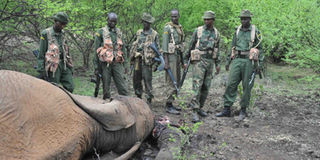Poaching threatens regional tourism

KWS rangers inspect the carcass of an elephant killed by the poachers. Elephant and rhino populations have of late dropped due to poaching, which adversely affects the tourism industry. PHOTO/KWS/FILE
What you need to know:
- Just the like the stars in the film, George and Joy Adamson, tourists arrive with high hopes of seeing the wild but beautiful scenery of Kenya, as well as its wildlife.
- Elephant and rhino populations have of late dropped due to poaching, which adversely affects the industry.
- According to the KWS, between January and March, 2013, poachers killed 74 elephants. In 2012, 384 elephants were killed, up from 289 poached in 2011.
By CAROLINE THEURI
The 1966 award-winning film, Born Free, best explains why Kenya is still alluring to tourists today.
Just the like the stars in the film, George and Joy Adamson, tourists arrive with high hopes of seeing the wild but beautiful scenery of Kenya, as well as its wildlife.
The tourism package is never complete without the safari to Kenya’s game reserves and national parks, where wildlife thrives. Yet, poaching threatens the wildlife and the larger tourism industry.
Elephant and rhino populations have of late dropped due to poaching, which adversely affects the industry.
According to a 2013 State of Kenya’s Economy report by the World Bank, there were 1.7 million visitors arriving at Jomo Kenyatta and Moi International Airports in Nairobi and Mombasa, respectively, in 2012.
In 2011, there had been 1.8 million tourist arrivals in these airports.
This is worrisome because the tourist industry is a major earner of the country’s foreign exchange.
The foreign exchange of Kenya consequently determines the strength of its currency and economic growth.
In 2012, tourism generated Sh96 billion, which made the industry Kenya’s major foreign exchange earner.
However, in the future, these figures may decline further if the poaching trend continues undeterred.
Elephants and rhinos are the most endangered animals.
Interceptions of illegal ivory at the port of Mombasa and other exit points has been on the rise.
For instance, in July 2013, the Kenya Revenue Authority (KRA) intercepted a container at the port of Mombasa with ivory worth Sh855 million.
There have been other similar interceptions of trophies headed to Asian countries by the KRA, the Kenya Wildlife Service and the police based at the port of Mombasa.
Government complicity
According to the KWS, between January and March, 2013, poachers killed 74 elephants. In 2012, 384 elephants were killed, up from 289 poached in 2011.
Conversely, in 1969, armed gangs poached the rhino leading to their population declining from 20,000 to 539 in 2010.
All these had an adverse effect on the Kenyan economy.
Though today’s conservation efforts encourage local communities to alert the KWS on poaching, in the 1970s, this was unheard of.
They abetted poaching since they hated the encroachment of elephant and rhinos into their land.
They were also paid by poachers to keep quiet about the illegal hunting.
The intervention of the World Bank pushed Kenya to ban poaching in 1977. In 1978, the government also banned the sale of all wildlife products.
Curio markets were hardest hit and poaching turned into a black market, however, politicians were still its main beneficiaries.
President Daniel Moi’s ascencion to power in 1979 brought hope in curbing the poaching trade. He launched an anti-poaching campaign that was largely effective.
For instance, whereas by 1980, Kenya had 360,000 foreign tourists who spent Sh170 million ($2 million) in foreign exchange, by 1988, the figure had increased to Sh30 billion ($350 million) at the current exchange rates.
President Moi realised that he needed someone with international links to aid Kenya’s tourism through wildlife conservation efforts.
In 1989, he appointed Dr Richard Leakey to head a new wildlife parastatal, the KWS.
The plan worked when Leakey managed to raise Sh269.5 million ($150 million) in aid of wildlife management.
Today, the rhinos are more endangered than elephants.
Public and private sector initiatives to save these wildlife include building sanctuaries such as the Rhino Ark organization in the Aberdares, Tsavo and Lake Nakuru national Parks.
Another recent method employed by the KWS and the World Wildlife Fund is installing microchips and scanners on rhinos to track their movement.
Conversely, there is a media campaign titled ‘‘Hands Off Our Elephant’’, which is meant to protect elephants from poachers.
First Lady Margaret Kenyatta is the main supporter of the campaign.
There have been criticisms by those in the legal fraternity that the Kenyan law abets the crime since it metes out lenient punishment for poachers.
Early this year, the Senior Principal Magistrate of Makadara Law Courts, Timothy Okello, criticised the Kenyan law for undermining conservation when he fined four Chinese men Sh18, 947 each after they were arrested for being in illegal possession of Sh1.2 million worth of ivory and trinkets.
They were arrested while in transit from the Democratic Republic of Congo (DRC) to Guangzhou, the China.
The future awaits Kenya’s Parliament to pass 2013 Wildlife Management and Conservation Bill and see whether it will protect Kenya’s wildlife from poaching.
It will make the punishment for poachers much more painful.


